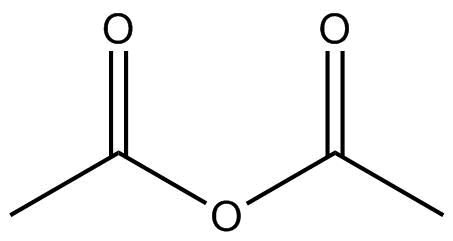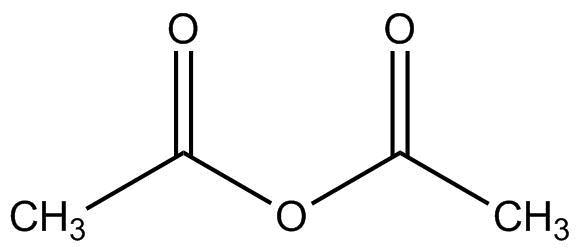
What is the IUPAC name of $ C{H_3}CO - O - OCC{H_3} $ ?
(A) Propanoic anhydride
(B) Ethanoic anhydride
(C) Pentanoic anhydride
(D) Methanoic anhydride
Answer
533.1k+ views
Hint : IUPAC naming system is a system for naming chemical compounds on the basis of an international system. Anhydride is a functional group with two acyl groups attached by an oxygen atom $ CO - O - OC $ . The carbon atoms on both sides are attached to the same carbon compound. Thus, the carbon compound name is attached to anhydride for IUPAC naming.
Complete Step By Step Answer:
IUPAC system is a system for naming a chemical compound on the basis of an international standard. This is known as nomenclature of the compound. It enables each compound to have a unique name which is common worldwide, this helps to increase the extent and feasibility of the compound as it is recognised in a similar method by everyone.
The number of carbon atoms determines the name of the chain of the compound. First we need to recognise the longest chain and start naming the compound from there. Then the functional groups attached to the chain need to be recognised and then the branching and bonding between the carbon atoms is determined, whether the compound is a chain structure or a ring structure or if it has single, double or triple bonds.
Anhydride is a functional group with two acyl groups joined by an oxygen atom $ CO - O - OC $ . The two carbon atoms on the sides are attached to the same carbon compound on both the sides. For IUPAC naming of the compound, anhydride is attached at the end of the IUPAC name of the carbon compound.
For the above question $ C{H_3}CO - O - OCC{H_3} $ .

This is known as anhydride where the same group of carbon atoms is attached on both the sides.

Thus, the IUPAC name of the given compound is Ethanoic Anhydride as the $ C{H_3} $ group is attached on both sides with $ CO - O - OC $ .
So, the correct option is (B) .
Note :
Anhydrides are obtained as a product of carboxylic acid and acid chloride which react in the presence of a base. Ethanoic anhydride is also known as acetic anhydride which is a colourless liquid. It has a strong odour like vinegar and is not a violently reactive compound. It is a combustible liquid which reacts with water to give acetic acid.
Complete Step By Step Answer:
IUPAC system is a system for naming a chemical compound on the basis of an international standard. This is known as nomenclature of the compound. It enables each compound to have a unique name which is common worldwide, this helps to increase the extent and feasibility of the compound as it is recognised in a similar method by everyone.
The number of carbon atoms determines the name of the chain of the compound. First we need to recognise the longest chain and start naming the compound from there. Then the functional groups attached to the chain need to be recognised and then the branching and bonding between the carbon atoms is determined, whether the compound is a chain structure or a ring structure or if it has single, double or triple bonds.
Anhydride is a functional group with two acyl groups joined by an oxygen atom $ CO - O - OC $ . The two carbon atoms on the sides are attached to the same carbon compound on both the sides. For IUPAC naming of the compound, anhydride is attached at the end of the IUPAC name of the carbon compound.
For the above question $ C{H_3}CO - O - OCC{H_3} $ .

This is known as anhydride where the same group of carbon atoms is attached on both the sides.

Thus, the IUPAC name of the given compound is Ethanoic Anhydride as the $ C{H_3} $ group is attached on both sides with $ CO - O - OC $ .
So, the correct option is (B) .
Note :
Anhydrides are obtained as a product of carboxylic acid and acid chloride which react in the presence of a base. Ethanoic anhydride is also known as acetic anhydride which is a colourless liquid. It has a strong odour like vinegar and is not a violently reactive compound. It is a combustible liquid which reacts with water to give acetic acid.
Recently Updated Pages
Master Class 11 Economics: Engaging Questions & Answers for Success

Master Class 11 English: Engaging Questions & Answers for Success

Master Class 11 Social Science: Engaging Questions & Answers for Success

Master Class 11 Biology: Engaging Questions & Answers for Success

Class 11 Question and Answer - Your Ultimate Solutions Guide

Master Class 11 Business Studies: Engaging Questions & Answers for Success

Trending doubts
What is meant by exothermic and endothermic reactions class 11 chemistry CBSE

10 examples of friction in our daily life

One Metric ton is equal to kg A 10000 B 1000 C 100 class 11 physics CBSE

Difference Between Prokaryotic Cells and Eukaryotic Cells

What are Quantum numbers Explain the quantum number class 11 chemistry CBSE

1 Quintal is equal to a 110 kg b 10 kg c 100kg d 1000 class 11 physics CBSE




